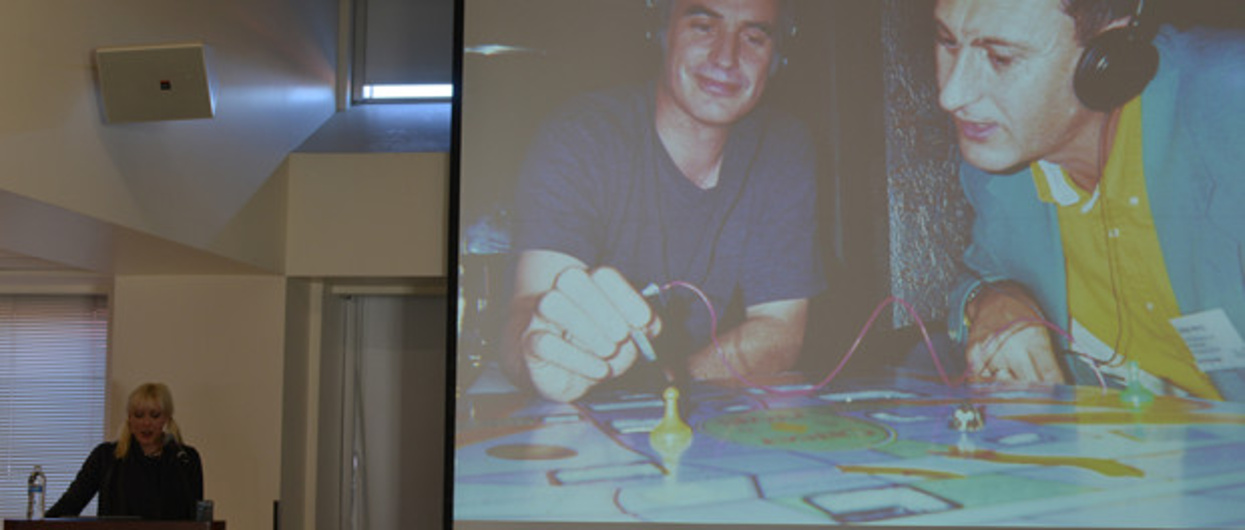Revisited: "Critical Play"

Kate Mattingly, a BCNM Designated Emphasis candidate in Theater, Dance, and Performance Studies, recaps Mary Flanagan’s History and Theory of New Media Lecture Series lecture “Critical Play,” which took place on March 17, 2016.
In entertainment sectors, a “triple threat” refers to performers who can sing, dance, and act exceptionally well, merging three seemingly distinct talents into one person. Mary Flanagan is a “triple threat” of game studies: she creates, designs, and publishes with seemingly ceaseless ingenuity and curiosity. At UC Berkeley on March 17, Flanagan visited Gail De Kosnik’s seminar in the History and Theory of New Media, where she discussed game design, social change, and her own projects, as well as recent conversations she’d been involved in that day as part of San Francisco’s Game Developers Conference 2016. Then at 5pm she delivered the final talk of the semester for the History and Theory of New Media lecture series. Entitled “Critical Play,” this presentation detailed histories of “critical” game design. It drew from Flanagan’s theories in her acclaimed books Critical Play: Radical Game Design (MIT Press, 2009) and, with NYU’s Helen Nissenbaum, Values at Play in Digital Games (MIT Press, 2014).
For Flanagan, the Sherman Fairchild Distinguished Professor in Digital Humanities at Dartmouth College, the word “critical” involves a type of analysis or inquiry and the word “play” suggests whimsy or fantasy. So the phrase “critical play” implies a contradiction, a kind of “analytical whimsy,” and it’s this paradox that she limns in her research and designs. Her first proposition, “Critical play examines dominant values,” foregrounds how games interrogate the ideologies of historical moments, such as the gendered and sexualized stereotypes we see in everyday life and narratives. Related to this idea, projects that dismantle an “achievement ideology”––level up or you’re dead––can be both jarring as well as educational and revealing. Flanagan offered these examples as ways of pointing to the potential of gaming to intervene in oppressive structures, and her own designs of games like Buffalo can reconfigure users’ racial and gender stereotypes.
More propositions followed, each one refining and highlighting Flanagan’s theories about gaming as holding the potential to intervene in assumptions and activate awareness. They are:
Proposition 2: Critical play examines dominant values
Proposition 3: Critical play can toy with the notion of goals, making games with problematic or unusual endings
Proposition 4: Critical play can lead us to impossible games
Proposition 5: Critical play emphasizes process
Proposition 6: Criticality can make familiar types of play unfamiliar
Flanagan’s examples of games’ roles in cultures spanned from the 13th century BC (The Book of the Dead, written by the 19th dynasty royal scribe Hunefer) to 17th century Dutch objects (Poppenhuis of Petronella Oortman) to 21st century digital installation (Cory Arcangel’s “Super Mario Clouds”). Flanagan emphasized how games reflect our attitudes towards gender relations (the first chess set had no female pieces) and offer opportunities to engage different cultural groups in shared, even collaborative, activities.
Drawing from art history, Flanagan showed examples of disharmonious play that spanned from a Brueghel painting (where children appeared to be tormenting each other) to a Giacometti object called “No More Play” (created in 1933 and a somber statement about war and violence). Flanagan explained how games are not a homogenous category, but a multifaceted, sometimes disturbing, assortment of interactions and ideas. In fact she prefers to think of games not as a media but a method or device, a “social technology.” Similar to our use of the term “story” or narrative, which can appear in theatre, film, and literature, “game” describes a set of interactions more than a medium. For Flanagan, gaming is “a higher level art form,” one that operates as its own art form and ludic language. Games present their own properties that are typically not found in sculpture or painting, such as challenge, risk, and reward. In Flanagan’s words, “Games are critical operations where transformation is triggered, where new relationships are formed and where the systems of everyday life meet the randomness of the universe.”
Ultimately, Flanagan believes games hold possibilities for socially positive and transformative change. For this reason her research sites span artistic, commercial, and educational sectors, and she has served on the White House Office of Science and Technology Policy (OSTP) Academic Consortium on Games for Impact. Her work has been supported by commissions and grants including The British Arts Council, the National Science Foundation, the National Institute of Justice, the National Endowment for the Humanities, Robert Wood Johnson Foundation (with Digital Mill), and the Institute of Museum and Library Services.
She’s less interested in political activism that takes the form of pranks or temporary diversion, and more concerned with how games can influence systemic shifts. Against a discourse of gaming as alienating or harmful, she’s interested in research that demonstrates “what games do,” and adds that this is a field we actually know little about. At the end of the day Flanagan sees games as “micro-solutions” for changing minds and behaviors, and her investment in art, game design, and scholarship is about “seeding our world with micro-solutions.”
Check out the photos below!

